Human-Altered Soils at an Archeological Site of the Bronze Age: The Tyater-Araslanovo-II Settlement, Southern Cis-Ural Region, Russia
Abstract
1. Introduction
2. Study Area
Environmental Characteristics of the Study Area
3. Materials and Methods
4. Results and Discussion
4.1. Soil-Pit Characteristics and Morphological Description
- AU, 0–12 cm. Dark gray, fine-grained, crumbly, moist, sandy clay loam (morphological description of soil texture was determined by feel); smooth transition in color.
- AUrr*, 12–21 cm. Light brown, dusty, crumbly, dry, sandy clay loam, inclusions of organic residues with a high degree of decomposition and fine gravel; transition to the next horizon is wavy in color.
- AU[hh], 21–69 cm. Dark gray, coarse-grained, loose, dry, sandy loam with inclusions of fragments of animal bones and fine gravel; transition to the next horizon is even in color.
- Q, 69–83 cm. Light bluish, large–medium prismatic, friable, dry, medium loamy with Fe–Mn nodules; carbonate impregnation; effervescence with 10% HCl.
- CQ, 83–100 cm. Bluish-brown, structureless, moist, silt loam with Fe–Mn nodules; carbonate impregnation; effervescence with 10% HCl.
- AU[hh], 42–70 cm. Dark gray, moist, powdery, crumbly, silt loam.
- Q, 70–85 cm. Bluish-red, dense, wet, with inclusions of reddish sand grains and fine gravel, structureless, sticky; effervescence with 10% HCl.
- AU[hh]pyr, 63–74 cm. Heterogeneously colored reddish-bluish-brown, structureless, silty and sticky clay loam.
- AU, 0–70 cm. Dark gray, medium–coarse-grained, friable, moist, sandy clay loam with a smooth transition in color to the lower horizon.
- Q, 70–90 cm. Light bluish, coarse–medium prismatic, friable and dry silt loam with dark gray streaks in the form of tongues from the overlying horizon; Fe–Mn nodules and carbonate impregnation; effervescence with 10% HCl.
- CQ, 90–120 cm. Bluish-brown, structureless and moist loam with Fe–Mn nodules and carbonate impregnation; effervescence with 10% HCl.
4.2. Particle Size Distribution
4.3. Chemical Properties
4.4. Group and Fractional Composition of Soil Organic Matter
5. Conclusions
Author Contributions
Funding
Institutional Review Board Statement
Informed Consent Statement
Data Availability Statement
Conflicts of Interest
References
- Dazzi, C.; Galati, A.; Crescimanno, M.; Papa, G.L. Pedotechnique applications in large-scale farming: Economic value, soil ecosystems services and soil security. Catena 2019, 181, 104072. [Google Scholar] [CrossRef]
- Bazarova, V.B.; Tsydenova, N.V.; Lyaschevskaya, M.S.; Khenzykhenova, F.I.; Tumen, D.; Erdene, M. Reconstruction of paleoenvironmental conditions of ancient people habitation in the Togootyn Gol River valley (Eastern Mongolia). Quat. Int. 2019, 503, 105–114. [Google Scholar] [CrossRef]
- Shtienberg, G.; Dix, J.K.; Shahack-Gross, R.; Yasur-Landau, A.; Roskin, J.; Bookman, R.; Waldmann, N.; Shalev, S.; Sivan, D. Anthropogenic overprints on natural coastal aeolian sediments: A study from the periphery of ancient Caesarea, Israel. Anthropocene 2017, 19, 22–34. [Google Scholar] [CrossRef][Green Version]
- Gong, Z.; Zhang, X.; Chen, J.; Zhang, G. Origin and development of soil science in ancient China. Geoderma 2003, 115, 3–13. [Google Scholar] [CrossRef]
- Rothschild, N.A.; di Zerega, W.D. Urban archaeology. In Encyclopedia of Archaeology; Pearsall, D.M., Ed.; Academic Press: New York, NY, USA, 2008; pp. 2164–2171. Available online: https://doi.org/10.1016/B978-012373962-9.00313-7 (accessed on 7 July 2021).
- Li, M.; Fang, H.; Zheng, T.X.; Rosen, A.; Wright, H.; Wright, J.; Wang, Y. Archeology of the Lu City: Place memory and urban foundation in Early China. Archaeol. Res. Asia 2018, 14, 151–160. [Google Scholar] [CrossRef]
- Macphail, R.I. Soils and archaeology. In Encyclopedia of Archaeology; Pearsall, D.M., Ed.; Academic Press: New York, NY, USA, 2008; pp. 2064–2072. Available online: https://doi.org/10.1016/B978-012373962-9.00290-9 (accessed on 7 July 2021).
- Crabtree, P.J.; Reilly, E.; Wouters, B.; Devos, Y.; Bellens, T.; Schryvers, A. Environmental evidence from early urban Antwerp: New data from archaeology, micromorphology, macrofauna and insect remains. Quat. Int. 2017, 460, 108–123. [Google Scholar] [CrossRef]
- Wouters, B.; Devos, Y.; Milek, K.; Vrydaghs, L.; Bartholomieux, B.; Tys, D.; Moolhuizen, C.; van Asch, N. Medieval markets: A soil micromorphological and archaeobotanical study of the urban stratigraphy of Lier (Belgium). Quat. Int. 2017, 460, 48–64. [Google Scholar] [CrossRef]
- Zubarev, V.; Smekalov, S.; Yartsev, S. Materials for the ancient landscape reconstruction in the Adzhiel landscape compartment in the Eastern Crimea (the first stage research results). J. Archaeol. Sci. Rep. 2019, 23, 993–1013. [Google Scholar] [CrossRef]
- Scudder, S.J.; Foss, J.E.; Collins, M.E. Soil science and archaeology. In Advances in Agronomy; Sparks, D.L., Ed.; Academic Press: New York, NY, USA, 1996; pp. 1–76. Available online: https://doi.org/10.1016/S0065-2113(08)60922-0 (accessed on 7 July 2021).
- Feinman, G.M. Settlement and landscape archaeology. In International Encyclopedia of the Social and Behavioral Sciences, 2nd ed.; Wright, J.D., Ed.; Elsevier: Amsterdam, The Netherlands, 2015; pp. 654–658. Available online: https://doi.org/10.1016/B978-0-08-097086-8.13041-7 (accessed on 7 July 2021).
- Nriagu, J. Environmental pollution and human health in ancient times. In Encyclopedia of Environmental Health, 2nd ed.; Nriagu, J., Ed.; Elsevier: Amsterdam, The Netherlands, 2019; pp. 598–614. Available online: https://doi.org/10.1016/B978-0-12-409548-9.11756-7 (accessed on 7 July 2021).
- Walkington, H. Soil science applications in archaeological contexts: A review of key challenges. Earth-Sci. Rev. 2010, 103, 122–134. [Google Scholar] [CrossRef]
- Hillson, S. Mammal Bones and Teeth. An Introductory Guide to Methods of Identification; Institute of Archaeology, University College London: London, UK, 1999. [Google Scholar]
- Wokken, G.G.; Glagolev, P.A.; Bogolyubsky, S.N. Pet Anatomy. System of Organs of Movement. Part 1; Higher school: Moscow, Russia, 1961; p. 391. [Google Scholar]
- Klimov, A.F. Anatomy of Domestic Animals; Lan: Saint Petersburg, Russia, 2003; p. 1040. (In Russian) [Google Scholar]
- Morgunova, N.L.; Vasilyeva, I.N.; Kulkova, M.A.; Roslyakova, N.V.; Salugina, N.P.; Turetskiy, M.A.; Fayzullin, A.A.; Khokhlova, O.S. Turganik Settlement in the Orenburg Region; OGPU: Orenburg, Russia, 2017; p. 300. (In Russian) [Google Scholar]
- Shishlina, N.; Roslyakova, N.; Kolev, Y.; Bachura, O.; Kuznetsova, O.; Kiseleva, D.; Retivov, V.; Tereschenko, E. Animals, metal and isotopes: Mikhailo-Ovsyanka I, the Late Bronze Age mining site of the steppe Volga region. Archaeol. Res. Asia 2020, 24, 100229. [Google Scholar] [CrossRef]
- Golyeva, A.; Khokhlova, O.; Shcherbakov, N.; Shuteleva, I. Negative effects of Bronze age human activity on modern soils and landscapes, a case-study on the Muradymovo settlement, Urals, Russia. Interdiscip. Archaeol. 2016, 7, 169–178. [Google Scholar] [CrossRef]
- Golyeva, A.; Khokhlova, O.; Lebedeva, M.; Shcherbakov, N.; Shuteleva, I. Micromorphological and chemical features of soils as evidence of bronze age ancient anthropogenic impact (Late Bronze Age Muradymovo settlement, Ural region, Russia). Geosciences 2018, 8, 313. [Google Scholar] [CrossRef]
- Krzewińska, M.; Kılınç, G.M.; Juras, A.; Koptekin, D.; Chyleński, M.; Nikitin, A.G.; Shcherbakov, N.; Shuteleva, I.; Leonova, T.; Kraeva, L.; et al. Ancient genomes suggest the eastern Pontic-Caspian steppe as the source of western Iron Age nomads. Sci. Adv. 2018, 4, eaat4457. [Google Scholar] [CrossRef]
- Shuteleva, I.A.; Shcherbakov, N.B.; Balonova, M.G.; Khokhlova, O.S.; Goleva, A.A. Some results of the application of a complex approach to the research of the Late Bronze age settlement in the Volgo-Ural region. Interdiscip. Archaeol. Nat. Sci. Archaeol. 2010, 1, 29–36. [Google Scholar] [CrossRef]
- Peel, M.C.; Finlayson, B.L.; McMahon, T.A. Updated world map of the Köppen-Geiger climate classification. Hydrol. Earth Syst. Sci. 2007, 11, 1633–1644. [Google Scholar] [CrossRef]
- IUSS Working Group WRB. World Reference Base for Soil Resources 2014, Update 2015. International Soil Classification System for Naming Soils and Creating Legends for Soil Maps. In World Soil Resources Reports; FAO: Rome, Italy, 2015; p. 182. [Google Scholar]
- Khaziev, F.K. Soils of Bashkortostan. Vol. 1. Ecologic-Genetic and Agroproductive Characterization; Gilem: Ufa, Russia, 1995; p. 385. (In Russian) [Google Scholar]
- Arinushkina, E.V. Agrochemical Methods of Soil Studies; Nauka: Moscow, Russia, 1970; p. 656. (In Russian) [Google Scholar]
- Orlov, D.S. Humic Substances of Soils and General Theory of Humification; Oxford and IBH Publishing: New Delhi, India, 1995. [Google Scholar]
- Kononova, M.M. Soil organic matter. In Its Nature, Its Role in Soil Formation and Soil Fertility; Pergamon Press: Oxford, UK, 1961. [Google Scholar]
- Vadyunina, A.F.; Korchagina, Z.A. Methods of Studying the Physical Properties of Soils; Agropromizdat: Moscow, Russia, 1986; p. 416. (In Russian) [Google Scholar]
- Prikhod’ko, V.E.; Sizemskaya, M.L. Basal respiration and composition of microbial biomass in virgin and agroforest-reclaimed semidesert soils of the Northern Caspian region. Eurasian Soil Sci. 2015, 48, 852–861. [Google Scholar] [CrossRef]
- Mohammadi, M.; Shabanpour, M.; Mohammadi, M.H.; Davatgar, N. Characterizing spatial variability of soil textural fractions and fractal parameters derived from particle size distributions. Pedosphere 2019, 29, 224–234. [Google Scholar] [CrossRef]
- Wang, J.; Zhang, J.; Feng, Y. Characterizing the spatial variability of soil particle size distribution in an underground coal mining area: An approach combining multi-fractal theory and geostatistics. Catena 2019, 176, 94–103. [Google Scholar] [CrossRef]
- Rubinić, V.; Lazarević, B.; Husnjak, S.; Durn, G. Climate and relief influence on particle size distribution and chemical properties of Pseudogley soils in Croatia. Catena 2015, 127, 340–348. [Google Scholar] [CrossRef]
- Holliday, V.T.; Gartner, W.G. Methods of soil P analysis in archaeology. J. Archaeol. Sci. 2007, 34, 301–333. [Google Scholar] [CrossRef]
- Rodrigues, S.F.S.; da Costa, M.L. Phosphorus in archeological ceramics as evidence of the use of pots for cooking food. Appl. Clay Sci. 2016, 123, 224–231. [Google Scholar] [CrossRef]
- Fenger-Nielsen, R.; Hollesen, J.; Matthiesen, H.; Andersen, E.A.S.; Westergaard-Nielsen, A.; Harmsen, H.; Michelsen, A.; Elberling, B. Footprints from the past: The influence of past human activities on vegetation and soil across five archaeological sites in Greenland. Sci. Total Environ. 2019, 654, 895–905. [Google Scholar] [CrossRef]
- da Costa, M.L.; Kern, D.C. Geochemical signatures of tropical soils with archaeological black earth in the Amazon, Brazil. J. Geochem. Explor. 1999, 66, 369–385. [Google Scholar] [CrossRef]
- Migliavacca, M.; Pizzeghello, D.; Busana, M.S.; Nardi, S. Soil chemical analysis support the identification of ancient breeding structures: The case-study of Cà Tron (Venice, Italy). Quat. Int. 2012, 275, 128–136. [Google Scholar] [CrossRef]
- Valente, G.J.S.S.; Costa, M.L. Fertility and desorption capacity of Anthrosols (Archaeological Dark Earth—ADE) in the Amazon: The role of the ceramic fragments (sherds). Appl. Clay Sci. 2017, 138, 131–138. [Google Scholar] [CrossRef]
- Zolotareva, B.N.; Bukhonov, A.V.; Demkin, V.A. The structural state of buried and surface soils of solonetzic complexes in the dry steppe zone of the Lower Volga basin. Eurasian Soil Sci. 2012, 45, 690–699. [Google Scholar] [CrossRef]
- Zolotareva, B.N.; Demkin, V.A. Humus in paleosols of archaeological monuments in the dry steppes of the Volga-Don interfluves. Eurasian Soil Sci. 2013, 46, 262–272. [Google Scholar] [CrossRef]
- Wittenberg, L.; van der Wal, H.; Keesstra, S.; Tessler, N. Post-fire management treatment effects on soil properties and burned area restoration in a wildland-urban interface, Haifa Fire case study. Sci. Total Environ. 2020, 716, 135190. [Google Scholar] [CrossRef] [PubMed]
- Gabbasova, I.M.; Garipov, T.T.; Suleimanov, R.R.; Komissarov, M.A.; Khabirov, I.K.; Sidorova, L.V.; Nazyrova, F.I.; Prostyakova, Z.G.; Kotlugalyamova, E.Y. The Influence of ground fires on the properties and erosion of forest soils in the Southern Urals (Bashkir State Nature Reserve). Eurasian Soil Sci. 2019, 52, 370–379. [Google Scholar] [CrossRef]
- Amoako, E.E.; Gambiza, J. Effects of anthropogenic fires on soil properties and the implications of fire frequency for the Guinea savanna ecological zone, Ghana. Sci. Afr. 2019, 6, e00201. [Google Scholar] [CrossRef]
- Francos, M.; Stefanuto, E.B.; Úbeda, X.; Pereira, P. Long-term impact of prescribed fire on soil chemical properties in a wildland-urban interface. Northeastern Iberian Peninsula. Sci. Total Environ. 2019, 689, 305–311. [Google Scholar] [CrossRef] [PubMed]
- Gonza’lez-Pe’rez, J.A.; Gonza´lez-Vila, F.J.; Almendros, G.; Knicker, H. The effect of fire on soil organic matter—A review. Environ. Int. 2004, 30, 855–870. [Google Scholar] [CrossRef] [PubMed]
- Gerlach, R.; Fischer, P.; Eckmeier, E.; Hilgers, A. Buried dark soil horizons and archaeological features in the Neolithic settlement region of the Lower Rhine area, NW Germany: Formation, geochemistry and chronostratigraphy. Quat. Int. 2012, 265, 191–204. [Google Scholar] [CrossRef]
- Säurich, A.; Tiemeyer, B.; Don, A.; Fiedler, S.; Bechtold, M.; Amelung, W.; Freibauer, A. Drained organic soils under agriculture—The more degraded the soil the higher the specific basal respiration. Geoderma 2019, 355, 113911. [Google Scholar] [CrossRef]
- Lull, C.; Bautista, I.; Lidón, A.; del Campo, A.D.; González-Sanchis, M.; García-Prats, A. Temporal effects of thinning on soil organic carbon pools, basal respiration and enzyme activities in a Mediterranean Holm oak forest. For. Ecol. Manag. 2020, 464, 118088. [Google Scholar] [CrossRef]
- Orlov, D.S.; Grishina, L.A. Workshop on the Chemistry of Humus; Moscow State University: Moscow, Russia, 1981; p. 272. (In Russian) [Google Scholar]
- Welte, E. Neuere ergebnisse der humusforschung. Angev. Chem. 1955, 67, 153–155. [Google Scholar] [CrossRef]
- Alekseeva, T.V.; Zolotareva, B.N.; Kolyagin, Y.G. Nonhydrolyzable part of soil organic matter in buried and modern soils. Eurasian Soil Sci. 2019, 52, 632–643. [Google Scholar] [CrossRef]
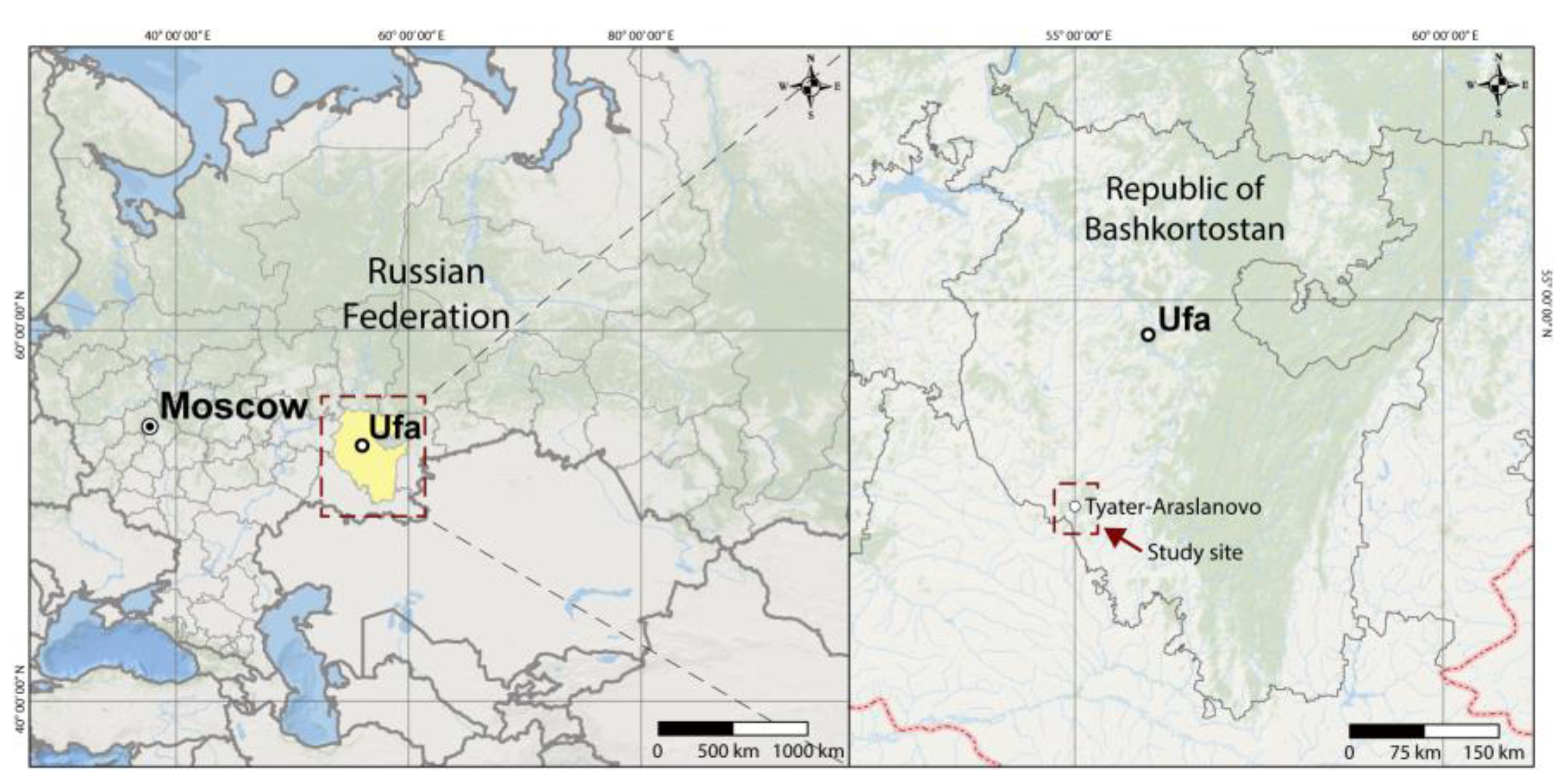

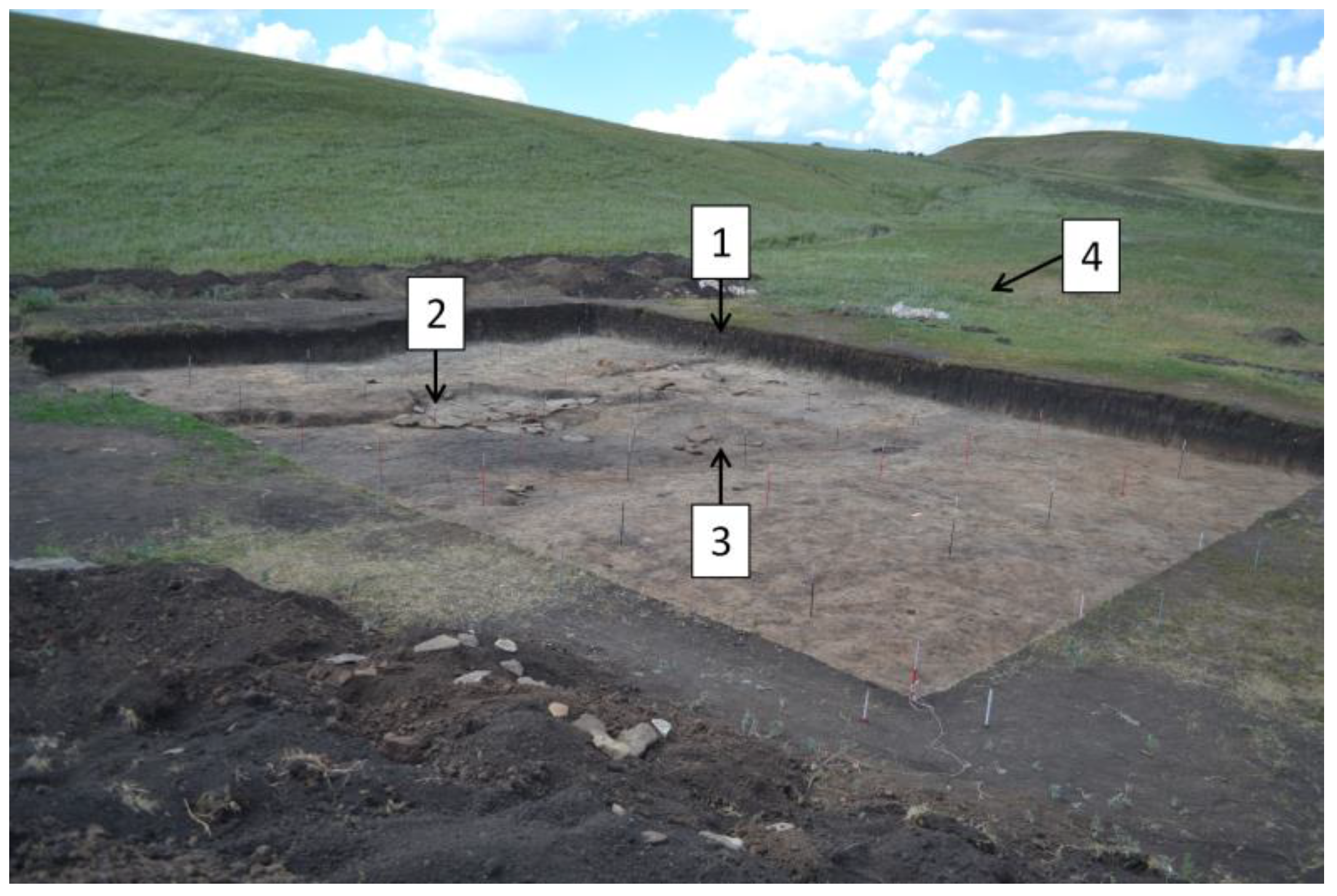
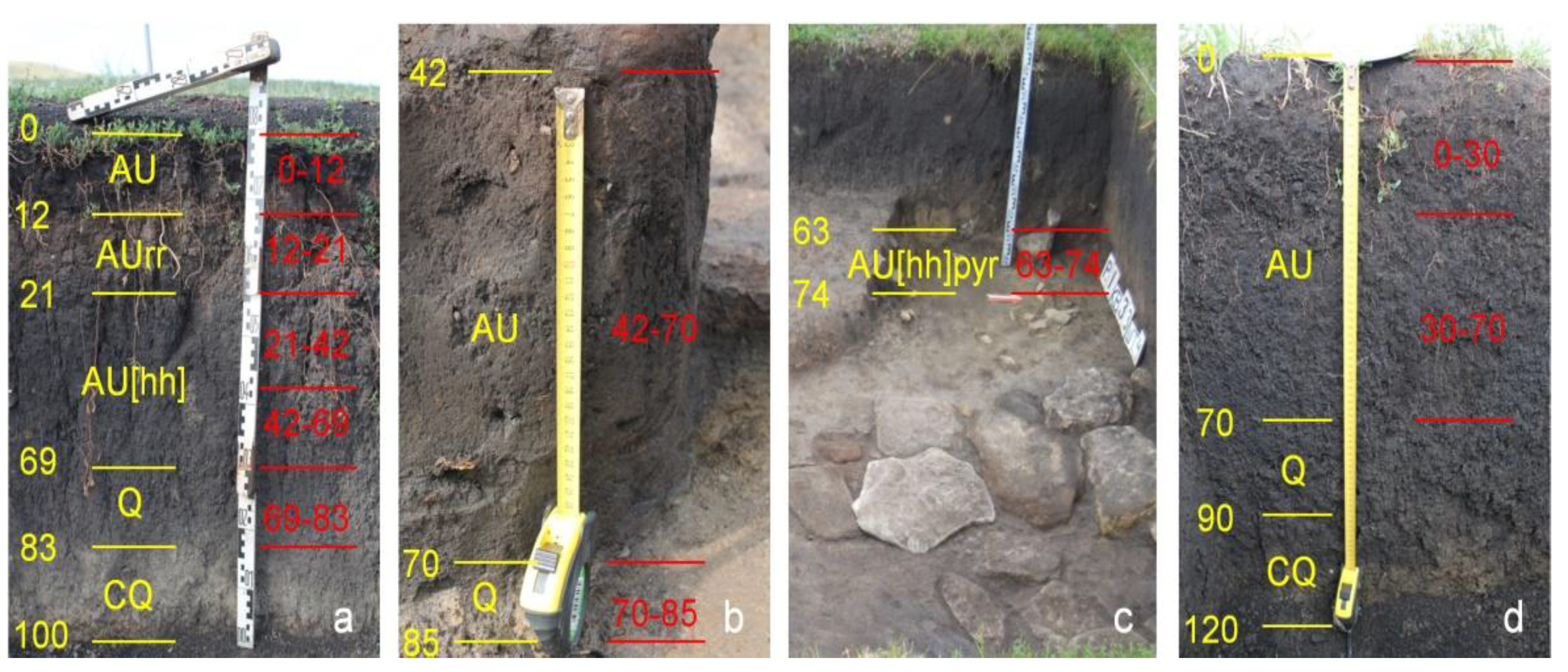
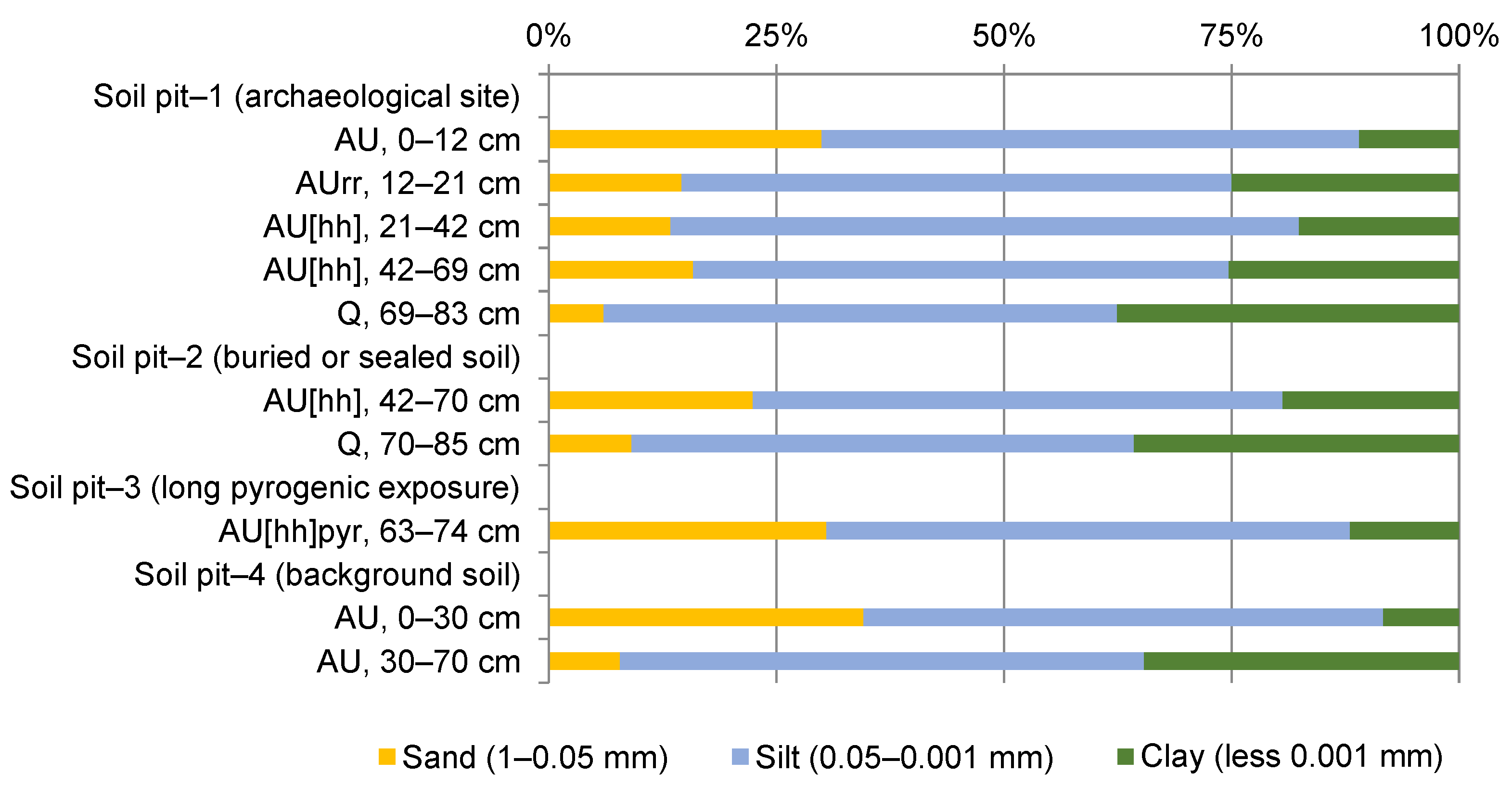
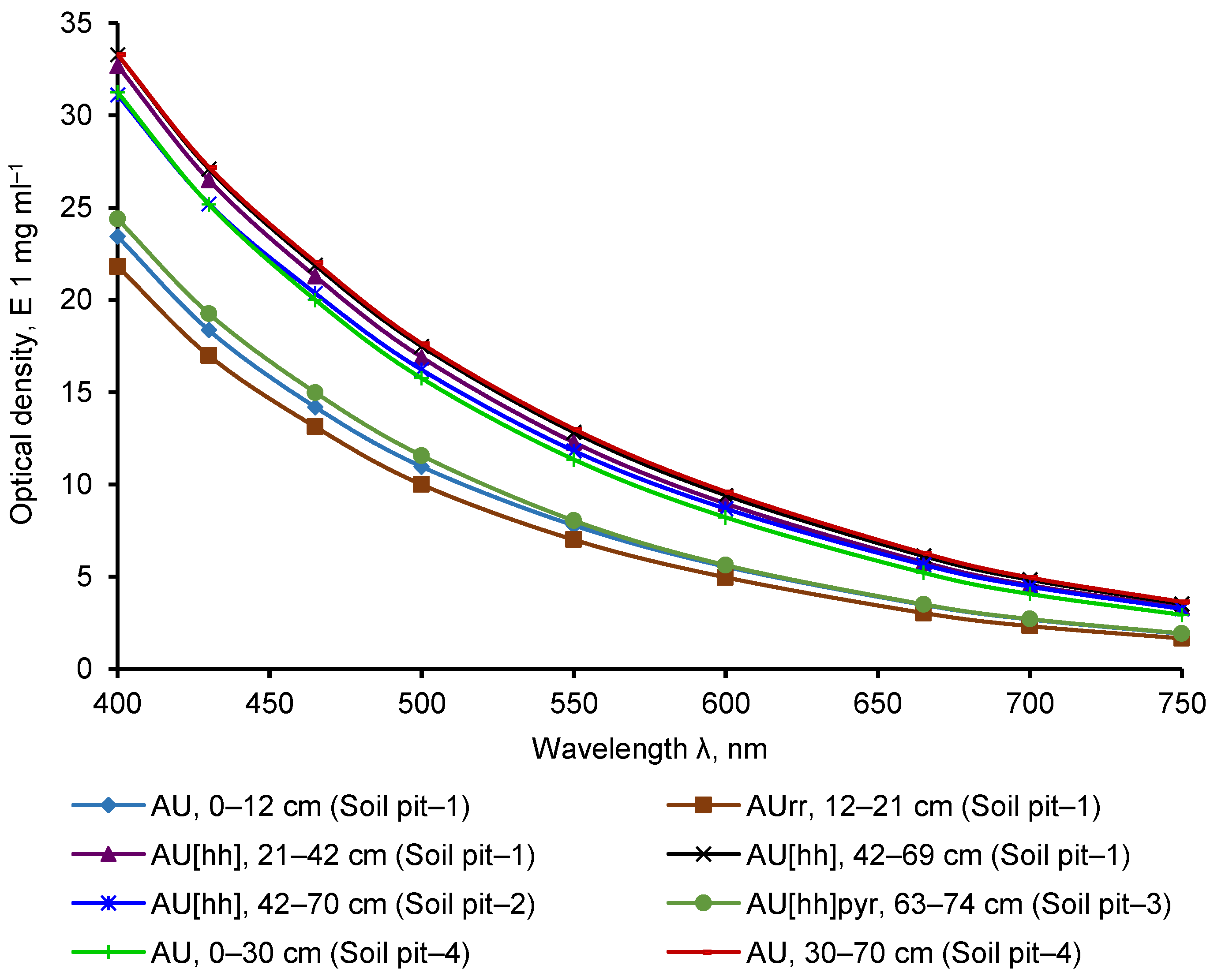
| Horizon and Sampling Depth, cm | Corg, % | BR | Ca2+ | Mg2+ | Ca2++Mg2+ | P2O5 | N, Alkaline Hydrolyzable | K2O, Mobile | pH (H2O) | |
|---|---|---|---|---|---|---|---|---|---|---|
| cmol(+) kg−1 | Total | Mobile | ||||||||
| mg kg−1 | ||||||||||
| Soil Pit 1 (archeological site) | ||||||||||
| AU, 0–12 | 8.79 | 1.31 | 46 | 9 | 55 | 3176 | 86.9 | 588 | 320 | 6.9 |
| AUrr, 12–21 | 8.33 | 2.98 | 38 | 6 | 44 | 2643 | 95.3 | 756 | 550 | 6.7 |
| AU[hh], 21–42 | 6.17 | 1.04 | 38 | 14 | 52 | 2746 | 93.1 | 280 | 275 | 7.4 |
| AU[hh], 42–69 | 3.77 | 0.78 | 37 | 14 | 51 | 2316 | 99.4 | 182 | 220 | 7.0 |
| Q, 69–83 | 1.46 | 0.22 | 36 | 6 | 42 | 1332 | 69.0 | 70 | 85 | 7.0 |
| Soil Pit 2 (buried or sealed soil) | ||||||||||
| AU[hh], 42–70 | 2.33 | 0.34 | 34 | 7 | 41 | 7602 | 96.2 | 140 | 800 | 7.4 |
| Q, 70–85 | 0.54 | 0.23 | 35 | 9 | 44 | 1619 | 101.2 | 42 | 115 | 7.3 |
| Soil Pit 3 (long pyrogenic exposure) | ||||||||||
| AU[hh]pyr 63–74 | 1.06 | 0.21 | 27 | 7 | 34 | 8135 | 92.2 | 98 | 1400 | 7.4 |
| Soil Pit 4 (reference soil) | ||||||||||
| AU, 0–30 | 7.82 | 1.29 | 40 | 9 | 49 | 2131 | 76.9 | 420 | 210 | 7.2 |
| AU, 30–70 | 3.41 | 0.97 | 40 | 8 | 48 | 1045 | 34.4 | 168 | 75 | 7.2 |
| Horizon and Sampling Depth, cm | Carbon of Humic Acids (HA) Fractions, in % to Corg | Carbon of Fulvic Acid (FA) Fractions, in % to Corg | HA/FA | Nonhydrolyzable Residue | |||||
|---|---|---|---|---|---|---|---|---|---|
| 1 | 2 | 3 | 1a | 1 | 2 | 3 | |||
| Soil Pit 1 (archeological site) | |||||||||
| AU, 0–12 | 13.65 | 20.43 | 10.69 | 1.73 | 9.83 | 0.00 | 0.90 | 3.59 | 42.77 |
| AUrr, 12–21 | 21.25 | 19.50 | 5.28 | 4.11 | 14.79 | 0.00 | 2.26 | 2.18 | 32.81 |
| AU[hh], 21–42 | 5.35 | 30.03 | 9.56 | 1.62 | 6.05 | 3.00 | 1.58 | 3.67 | 42.81 |
| AU[hh], 42–69 | 3.71 | 47.23 | 7.43 | 1.70 | 2.29 | 3.00 | 1.35 | 7.00 | 33.29 |
| Q, 69–83 | 2.05 | 33.52 | 8.22 | 6.82 | 0.00 | 6.20 | 2.76 | 2.78 | 40.43 |
| Soil Pit 2 (buried or sealed soil) | |||||||||
| AU[hh], 42–70 | 9.44 | 43.82 | 9.44 | 1.81 | 5.53 | 4.00 | 0.90 | 5.12 | 25.06 |
| Q, 70–85 | 3.7 | 42.60 | 7.41 | 3.19 | 9.78 | 0.00 | 7.41 | 2.64 | 25.91 |
| Soil Pit 3 (long pyrogenic exposure) | |||||||||
| AU[hh]pyr, 63–74 | 9.43 | 21.73 | 6.60 | 8.23 | 5.01 | 9.20 | 3.78 | 1.44 | 36.02 |
| Soil Pit 4 (the reference soil) | |||||||||
| AU, 0–30 | 7.93 | 27.52 | 9.72 | 1.41 | 6.8 | 0.00 | 1.68 | 4.57 | 44.94 |
| AU, 30–70 | 2.05 | 48.93 | 8.80 | 1.45 | 4.37 | 0.00 | 0.88 | 8.92 | 33.52 |
| Horizon and Sampling Depth, cm | Humus, % | Type of Humus | Fractions of HA, % from Σ HA | ||
|---|---|---|---|---|---|
| 1 | 2 | 3 | |||
| Soil Pit 1 (archeological site) | |||||
| AU, 0–12 | 15.15 vh | Humate | 30.5 l | 45.6 m | 23.9 h |
| AUrr, 12–21 | 14.35 vh | Humate | 46.2 m | 42.4 m | 11.5 m |
| AU[hh], 21–42 | 10.63 vh | Humate | 11.9 vl | 66.8 h | 21.3 h |
| AU[hh], 42–69 | 6.50 h | Humate | 6.4 vl | 80.9 vh | 12.7 m |
| Q, 69–83 | 2.52 l | Humate | 4.7 vl | 76.5 h | 18.8 m |
| Soil Pit 2 (buried or sealed soil) | |||||
| AU[hh], 42–70 | 4.01 m | Humate | 15.1 vl | 69.9 h | 15.1 m |
| Q, 70–85 | 0.93 vl | Humate | 6.9 vl | 79.3 h | 13.8 m |
| Soil Pit 3 (long pyrogenic exposure) | |||||
| AU[hh]pyr, 63–74 | 1.83 vl | Fulvate–humate | 25.0 l | 57.5 m | 17.5 m |
| Soil Pit 4 (background soil) | |||||
| AU, 0–30 | 13.47 vh | Humate | 17.6 vl | 60.9 h | 21.5 h |
| AU, 30–70 | 5.88 m | Humate | 3.4 vl | 81.9 vh | 14.7 m |
| Horizon and Sampling Depth, cm | Optical Density, E 1 mg ml−1, 430 nm | Chromaticity Coefficient, E465 nm: E665 nm | ||||
|---|---|---|---|---|---|---|
| 1 | 2 | 3 | 1 | 2 | 3 | |
| Soil Pit 1 (archeological site) | ||||||
| AU, 0–12 | 7.84 | 18.36 | 11.43 | 7.13 | 4.09 | 4.06 |
| AUrr, 12–21 | 5.51 | 16.98 | 12.82 | 4.18 | 4.33 | 3.67 |
| AU[hh], 21–42 | 17.32 | 26.50 | 20.75 | 5.92 | 3.68 | 3.42 |
| AU[hh], 42–69 | 6.33 | 27.10 | 18.61 | 6.57 | 3.58 | 3.51 |
| Q, 69–83 | 2.08 | 20.58 | 21.48 | 5.69 | 3.98 | 3.67 |
| Soil Pit 2 (buried or sealed soil) | ||||||
| AU[hh], 42–70 | 15.23 | 25.21 | 19.39 | 5.15 | 3.61 | 3.26 |
| Q, 70–85 | 1.01 | 18.68 | 13.07 | 2.78 | 3.97 | 3.85 |
| Soil Pit 3 (long pyrogenic exposure) | ||||||
| AU[hh]pyr, 63–74 | 12.43 | 19.26 | 16.94 | 5.66 | 4.28 | 3.81 |
| Soil Pit 4 (background soil) | ||||||
| AU, 0–30 | 13.05 | 25.18 | 15.63 | 6.38 | 3.84 | 3.72 |
| AU, 30–70 | 4.93 | 27.20 | 20.16 | 7.28 | 3.51 | 3.31 |
Publisher’s Note: MDPI stays neutral with regard to jurisdictional claims in published maps and institutional affiliations. |
© 2021 by the authors. Licensee MDPI, Basel, Switzerland. This article is an open access article distributed under the terms and conditions of the Creative Commons Attribution (CC BY) license (https://creativecommons.org/licenses/by/4.0/).
Share and Cite
Suleymanov, R.; Obydennova, G.; Kungurtsev, A.; Atnabaev, N.; Komissarov, M.; Gusarov, A.; Adelmurzina, I.; Suleymanov, A.; Abakumov, E. Human-Altered Soils at an Archeological Site of the Bronze Age: The Tyater-Araslanovo-II Settlement, Southern Cis-Ural Region, Russia. Quaternary 2021, 4, 32. https://doi.org/10.3390/quat4040032
Suleymanov R, Obydennova G, Kungurtsev A, Atnabaev N, Komissarov M, Gusarov A, Adelmurzina I, Suleymanov A, Abakumov E. Human-Altered Soils at an Archeological Site of the Bronze Age: The Tyater-Araslanovo-II Settlement, Southern Cis-Ural Region, Russia. Quaternary. 2021; 4(4):32. https://doi.org/10.3390/quat4040032
Chicago/Turabian StyleSuleymanov, Ruslan, Gulnara Obydennova, Andrey Kungurtsev, Niyaz Atnabaev, Mikhail Komissarov, Artyom Gusarov, Ilgiza Adelmurzina, Azamat Suleymanov, and Evgeny Abakumov. 2021. "Human-Altered Soils at an Archeological Site of the Bronze Age: The Tyater-Araslanovo-II Settlement, Southern Cis-Ural Region, Russia" Quaternary 4, no. 4: 32. https://doi.org/10.3390/quat4040032
APA StyleSuleymanov, R., Obydennova, G., Kungurtsev, A., Atnabaev, N., Komissarov, M., Gusarov, A., Adelmurzina, I., Suleymanov, A., & Abakumov, E. (2021). Human-Altered Soils at an Archeological Site of the Bronze Age: The Tyater-Araslanovo-II Settlement, Southern Cis-Ural Region, Russia. Quaternary, 4(4), 32. https://doi.org/10.3390/quat4040032









